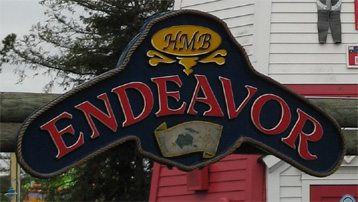

HMB Endeavor
DATA:
When the ride is at its top speed:
The time for one loop: __________ secThe maximum acceleration: ________ g's
The minimum acceleration: ________ g's
QUESTIONS (Qualitative):
1. In each arc, after the ride gets to full speed, where do you feel each of the following:a) the strongest push against your back?b) the least push against your back?
c) the strongest push against your seat?
d) the least push against your seat?
2. Where do you feel you are going the fastest? Why?
3. Hold your accelerometer in front of you during the ride. Observe carefully the motion of the suspended mass.
a) In what part of the ride was the mass pulled farthest down the tube?
b) At the top of the arc, how far "down" was the mass pulled?
4. Invert the accelerometer at the top of the arc when you are going full speed, and observe the reading. Is it [equal to, less than, or more than] 1 g? Explain.
5. If you were not wearing the shoulder harness, would you fall out of the ride at the top when it is going full speed? Explain. (Use good physics in your explanation.)
DATA:
A SPOT is provided at the covered bridge between KidZville and Boomerang Bay where the horizontal distance to Endeavor is measured carefully. Use this SPOT to complete the work that follows.
When the ride is at its top speed:
The time for one loop: __________ secRadius of the circular path: ________ m
Measured on the ride:
The maximum acceleration: __________ g'sThe minimum acceleration: __________ g's
CALCULATIONS: (show your equations)
1. What is the approximate circumference of the loop? (m)
2. What is the average velocity (considered constant) around the loop? (m/sec)
3. What is the centripetal acceleration while traveling in the loop, using the v from #2? (v2 / R) [in m/sec2 & g's]
4. What is the maximum and minimum acceleration that one should experience, given your calculations in #3 above?
5. Compare your theoretical values with the ones you obtain(ed) while on the ride. Hint: You may need to turn your accelerometer upside down at the top of the loop!
6. Why might there be serious discrepancies between theoretical and measured values?
Click here for Word version of this worksheet
Click here for pdf version of this worksheet
Updated 1/26/2012